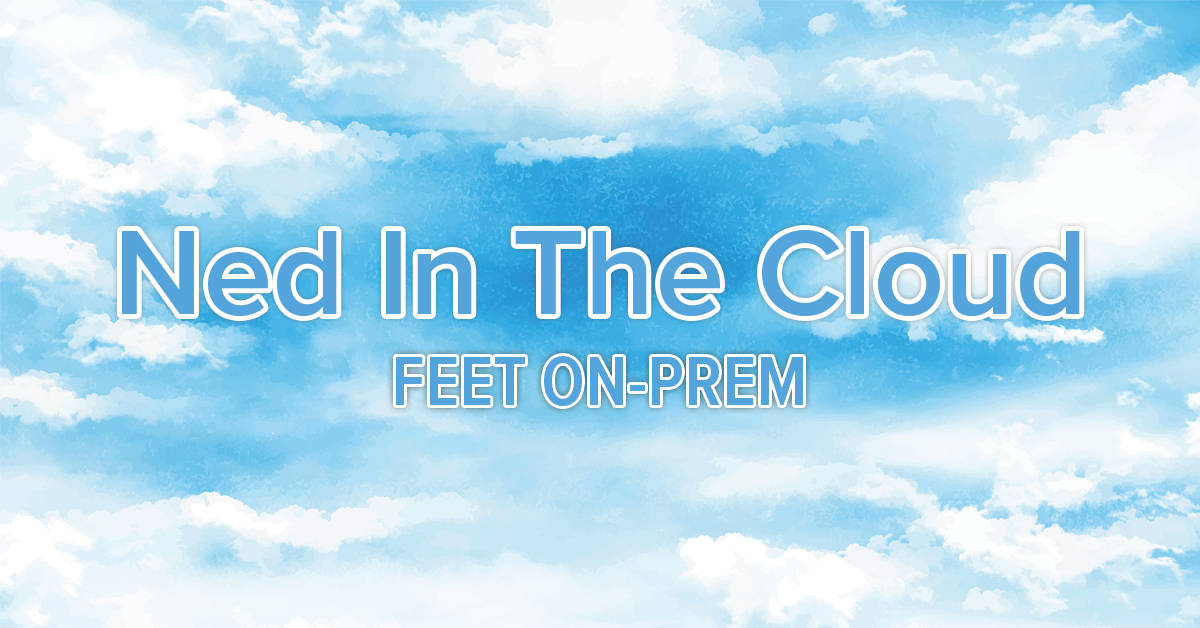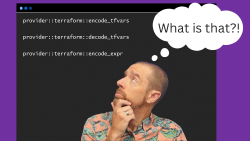


Three months ago I decided to leave the world of VAR consulting and try my hand at a new venture. That new venture is Ned in the Cloud LLC. I wrote a long post about the events that led up to my decision and I encourage you to go check that out if you have questions. The focus of Ned in the Cloud is to create technical content that is educational in nature. That could be courses on Pluralsight, sponsored blog posts about vendor technology, webinars about a technical topic, podcasts about the cloud, or even a book about the Azure Kubernetes Service. The unifying thread is a desire to learn about technology and share that knowledge with others. Now that I have been doing this for a full quarter, I thought it might be nice to post an update about how things are going so far.
When I started this voyage three months ago, there were several items of concern that fell into three basic categories: Financial, Business, Personal. Let’s dive into those categories a bit and see what I was worried about, and how I’ve fared in the last 90 days.
Ned in the Cloud LLC is not a publicly traded company or anything, so I won’ be divulging any specific numbers. But I did have some concerns on the financial end of things. I was worried about building and maintaining a pipeline of work, effectively tracking my financials, dealing with accounting, and properly structuring for taxes.
When it comes to building and maintaining a pipeline, I needn’t have worried. In fact, I overstuffed the pipeline with work, and as a result the last two weeks of May and all of June were completely packed with work. I was working eight hour days and sometimes nights to hit all my deadlines. This was not my intention when I decided to strike out on my own. I’ll talk about that more in the personal section, but suffice to say that working less was one of my goals when I quit my previous job. In my worried state over pipeline, I made the mistake of saying “yes” to any opportunity that presented itself. My key takeaway is that it’s okay to say “no” to opportunities when you don’t have sufficient bandwidth to get them done. Saying “no” doesn’t slam a door on future opportunity, in fact it communicates to the prospect that you are in high demand! I have also created an Excel spreadsheet to track my pipeline of opportunities to help make financial projections. It’s very much a work in progress, but it’s nice to have some visibility into future earnings.
In terms of tracking my financials and dealing with accounting, I got a free 12-month membership to Quickbooks Self-Employed because I did my taxes through TurboTax at the small business tier for 2018. I’ve been using Quickbooks to track my income and spending. One of the things I wish I had done sooner was to get a dedicated checking account and business credit card to completely separate business and personal finances. I had the checking account in place three months ago, but I didn’t have the credit card until mid-June. Once I had both, I went through all the business related accounts, like AWS and my Wordpress hosting, and moved them to the business credit card. That makes tracking finances way easier. I can also use Quickbooks to do invoicing for clients. I won’t be using TurboTax for my taxes next year, more on that in a moment, but I will probably pay up for another year of Quickbooks. The key takeaway I have here is to separate my finances as much as possible, and avail myself of software that makes the whole process simpler.
There’s only two things that are certain in life, death and taxes. And I’m not so sure of the death thing. Back in April, I engaged with an accountant to figure out how to structure my company for tax purposes. Based on the expected income, he recommended that I structure as an S-corp. Of course, being an S-corp is much more complicated than continuing to file as an individual. But there are lots of potential savings when it comes to taxes. If I filed as a self-employed person, then all of my income would be subject to standard income tax rates, whereas as an S-corp only the salary I pay myself is subject to said taxes. It also means that I need to pay unemployment and worker’s compensation taxes. Things get complicated quickly, so I hired the accountant I mentioned earlier to handle all of my tax related affairs. Unless you really like digging into the fascinating world of corporate taxes, I highly recommend getting a good CPA and letting them handle it.
A business is more than just financials; it’s marketing, IT, customer service, strategy, etc. When I was working for someone else, I could leave many of the business related activities to them and focus on my job responsibilities. What I quickly realized in starting my own business is that I am now responsible for all of these activities. No one is going to take care of my marketing, set the strategy for the next three years, or manage my ongoing projects.
To that end, I have started using several applications to try and manage my workflow and marketing. I was already using Buffer and Zapier to automate posts across social media, and I have continued to lean in to those platforms for marketing. I also had to go through all of profiles on multiple websites and update my status to include the company website and contact information. Here is the short list of apps that I’ve started using:
I am also forced to use some other solutions as part of working with partners. For example, I have to use Google Docs, Drive, and Sheets with a few partners because that is their workflow. Another one uses Asana, which I’ve never touched before. I am the small fish in all of these situations, so I need to adapt to whatever each partner prefers to use for their workflow.
My larger strategic vision for the company has not changed. I don’t have a mission statement as such, but it really boils down to creating technical content for the purpose of educating others. That’s the high level vision, and it’s up to me to transform that vision into a strategy and a tactical plan. Currently my largest partner is Pluralsight, from both a workload and revenue perspective. It is a fantastic platform to create educational content of a technical nature, but I want to diversify and add new clients to the roster. Generally you don’t want a majority of your work and income coming from a single source. That constitute a significant business risk if something happens to the relationship with that client. Fortunately, I have been building relationships with others in the technical community, and that has resulted in several opportunities to write, podcast, and host webinars. Over the next few years I am planning to continue to cultivate those relationships while also looking to create some original content that is more direct to consumer, so I am not entirely reliant on clients and partners for my income.
There were two things I was concerned with when it came to my personal life: maintaining work/life balance and working from home.
I’ve heard some serious horror stories about people starting their own business and suddenly working 80 hour weeks and questioning why they ever did this foolish thing to start with. I did not want to become one of those people. Prior to quitting my previous job, I was already working way too much. I had my regular 40-hour a week job, and then I was doing a bunch of things to build up my side-hustle, which would eventually become my full-time job. Authoring Pluralsight courses, writing sponsored blog posts, recording podcasts, all of these things were adding at least another 20 hours of work to my week. The whole point of doing all this side-hustle work was to build up a business that was ready to launch without the 80 hour work weeks. I am happy to report that my plan worked. I’ve been able to maintain a maximum of 40 hours a work, with the exception of the end of June. In my worry over having enough work in the pipeline, I over-committed myself in June, and as a result I had to work a few nights in the final two weeks to hit my deadlines. Then I took the first two weeks of July off, restoring balance to my life.
I am a creature of routine, as I think many of us are. Part of maintaining a good balance and my own mental health was establishing a new routine around the house. Even though I set my own hours, I still need some semblance of structure. Previously I would get all the kids up by 6:30AM, get them fed and dressed, and be out the door by 7:15AM or so. I would drop the kids off and be at work by 8:00AM and work until 4:30PM. Even when I worked from home, that was my general schedule. Now that I am able to make my own schedule, it didn’t make sense to drop the kids off so early, and I could save money by not sending my oldest to before-care at the elementary school. Instead, I settled into a routine of getting them up by 7:30AM - if they didn’t wake themselves up - and heading out by 8:15AM for drop-off in the car line. By the time I dropped them all off and returned home, I was able to eat breakfast and start work by 9AM. I would work until 4:30PM or 5PM at the latest, with a 30 minute break for lunch. Even once school ended and summer started, I have kept this schedule. My pro-tip here is to create a schedule for yourself and stick to it as much as possible. It provides a solid separation of work and personal life, which could otherwise become a bit blurred.
Speaking of work and life being blurred, another thing I did before leaving my old job was to get a dedicated office space in the basement of my house. We had wanted to get the basement finished since we moved into the house, and having a dedicated office served as a catalyst to finally doing it. Now I have a space carved off that is specifically for doing work, with a door that shuts and locks. When I am in my office, I am at work. Sometimes I do some work sitting in the sunporch or in front of the TV, as I did before I left my old job, but the majority of my work is happening in my office. Also important, since it is summer and the kids are home, they know that when I am in my office, I am not accessible. Go ask mom, unless it’s an emergency. And no, being unable to find your missing Shopkins does not constitute an emergency.
I did have two more concerns of a personal nature that my prior work addressed. First, I was worried about not getting enough social contact. Like many IT professionals, I am not the most social person. I do not need to spend all day around other people, and in many cases I find that I am more productive when left alone. But there is a lot to be said for the casual interaction that happens around an office. You have random conversations that spark a new idea, or a hallway chat helps solve an issue you were kicking around. Getting up from your desk, and getting out of your own head-space is important. By working 100% remote and without any actual co-workers, I was giving up that aspect of social interaction. My solution, so far, has been to make sure and go out to lunch with someone at least once a week. That gets me out of the house, and it gives me a reason to reach out and connect with people I might not have seen in a while. I have also been making ample use of online social interaction with things like Slack, Zoom, WhatsApp, and even Twitter. Finally, I go back to my old work every Friday to record Buffer Overflow, providing yet another avenue of social interaction.
The second concern I had was one of travel anxiety. I’ll be blunt here, travel makes me anxious and my anxiety expresses itself through intestinal discomfort. When I say travel, I could mean driving to a client site, flying to a conference, or taking the train up to NYC. It’s not the mode of transport necessarily, although driving myself makes me the least anxious. It is more the uncertainty and loss of control that is inherent in travel. You are no longer in a space that you control, i.e. home. And unless you are driving a car by yourself, you no longer control your mode of transport either. What I have discovered is that the more I travel, the less anxious travel makes me. My brain gets conditioned to frequent travel, and doesn’t have time to fixate on a particular trip. Working as a consultant for six years meant a lot of travel - mostly local, but still a lot of travel - to unfamiliar places to meet new people. The repetition of doing so has built up a level of tolerance to travel that I didn’t used to have. My fear was that I would lose that level of tolerance if I were no longer traveling as much with the new job. At this point, I don’t know if my tolerance is changing, since I haven’t been traveling for work at all since May. I do have a number of trips coming up in late summer and early fall that will test my tolerance.
I don’t really have a way to address this issue. As I said, traveling for consulting was mostly day trips to regional locations, so I was always home at night with my family. There were occasional conferences that had me going away for multiple days, but the majority of my travel was to client sites. My new job doesn’t require me going to client sites on a regular basis, so that option is out. I could go to more conferences, but I don’t want to. I value my time with my family too much to spend a week away every month at a different conference. For now, this concern appears to be a wait and see type situation. All I can do is be mindful of it.
Whew! I guess I had a lot to say after 90 days! If you’re thinking about going independent, I hope you’ve found some part of this helpful. If you’ve got advice for me moving forward, I’d love to hear it. Overall, I have to say that I LOVE my new job. It has improved my mental state, my home life, and my enjoyment of work. Financially it was a pay-cut, but personally it was a huge raise. I know which one I value more.
Using Provider Defined Functions in Terraform
July 18, 2024

Variable Validation Improvements in Terraform 1.9
July 8, 2024

July 6, 2024
